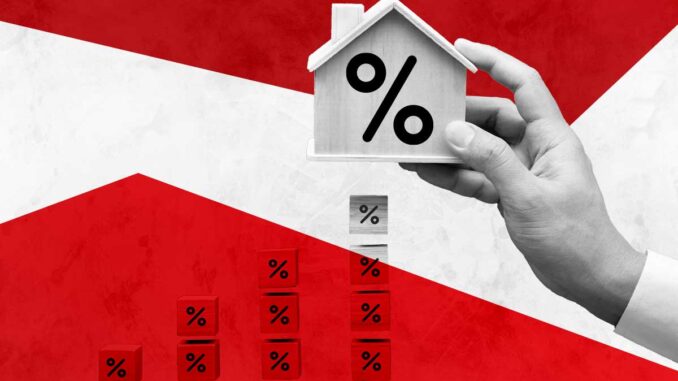
The private-label and agency mortgage-backed securities (MBS) markets, the primary sources of liquidity for many mortgage lenders, are taking a beating so far this year.
That dour performance mirrors what’s happening in the primary mortgage market — where origination volume is down drastically year to date in 2023.
There’s no sugar-coating that stark takeaway, several industry observers said. The math bears it out.
Ben Hunsaker, a portfolio manager focused on securitized credit for Beach Point Capital Management, said in the current volatile high-rate environment, it’s been difficult for issuers to execute deals in the private-label space that offer more than a very thin gain in terms of net interest margin. Consequently, he said, in addition to high rates keeping many would-be homeowners on the sidelines, many thinly capitalized independent mortgage lenders (IMBs) are “not going to push” non-agency origination volume right now because of the execution hurdles in the secondary market.
“The return for the origination dollars they’re putting out just isn’t that great … and they might have to take credit risks [on new loans] that they wouldn’t have otherwise have to take,” risking what little capital they have left to spare, Hunsaker explained.
For agency loans, there’s a similar problem facing lenders. Hunsaker said the interest rate that IMBs need to charge the borrowers “in order for them to securitize [loans through the agencies] and make a profit has to be pretty darn high, to the point where it’s going to drive down volume.”
“So, that’s why you’ve see them [IMBs] all cut material amounts of headcount in their origination channels and their loan officers, etc., because their cost structure has to shrink,” Hunsaker said. “So, it’s a really tough environment, and they’re [IMBs] very much relying on their retained mortgage-servicing portfolios to keep the lights on at this juncture.”
The MBS math
A report released Thursday by real estate data firm ATTOM shows that in the first quarter of 2023, 1.25 million single-family home mortgages were originated nationwide — the lowest mark since 2000. The first-quarter 2023 origination volume is down 19% from the final quarter of 2022, representing the eighth quarterly decrease in a row; and its down by 56% compared with the first quarter of 2022; and off 70% from the the first quarter of 2021.
“Lenders saw opportunities dwindle even more during the first quarter as the longest slowdown in mortgage activity in at least 20 years continued,” said Rob Barber, ATTOM’s CEO. “… The latest slide extends a run that started two years ago and has carved away nearly three-quarters of the home-mortgage business.
“Things remain uncertain in the near future, with the potential for interest rates and inflation to go either way, but the spring buying season will be a key indicator of whether things may turn around.”
The performance and outlook for the secondary mortgage markets are equally grim. A recent report by Kroll Bond Rating Agency (KBRA) shows that issuance of private-label prime, nonprime and credit-risk transfer residential mortgage-backed securities (known as RMBS 2.0) stood at only $13 billion in the first quarter of this year, “the second lowest quarter in the last three years, only higher than Q4 2022 at approximately $7 billion.”
KBRA projects that 2023 RMBS 2.0 issuance will “be just over $65 billion, down 36% from … $102 billion in 2022.”
“…We expect all sectors to decline in the remainder of 2023, mainly due to sharp interest rate increases that have decreased overall mortgage production and have made refinancing unattractive,” the KBRA report states.
Also greatly depressed is the performance of the agency MBS market — which, for the purposes of this analysis, includes Fannie Mae, Freddie Mac and Ginnie Mae. Data from SIFMA, a leading trade group representing broker-dealers, investment banks and asset managers, shows that year to date through April of this year, all-agency MBS issuance stood at $291 billion, down from $826 billion for the same period in 2022.
A recent report from real estate investment firm The Amherst Group forecasts that the net issuance of agency MBS is projected at $325 billion for 2023 and $375 billion for 2024. Those figures reflect a substantial reduction in new and existing-home sales and refinancing.
By comparison, agency net MBS issuance in 2021, when interest rates were half of what they are today, came in at $870 billion. Net issuance in MBS represents new securities issued less the decline in outstanding securities due to principal paydowns or prepayments.
Volatile times
In recent weeks, the flap in the U.S. Congress over whether the nation’s debt ceiling would be raised or not also factored into the already volatile rate environment. The pending resolution of that crisis — marked by bipartisan approval of a debt-ceiling deal in the House on Wednesday evening, May 25 — represents a huge tragedy averted to be sure, according to market observers. Still, it doesn’t solve the underlying issues depressing mortgage originations and related secondary-market issuances.
“I believe by the time by the time you release this story, the debt ceiling will be fixed,” said Ryan Craft, CEO of real estate advisory and asset-management firm Saluda Grade, in an interview late last week. “And, if it’s not, then nobody’s going to be reading this story because there’s going to be huge, huge problems.
“I believe that investors have been calm about it and handled it [the debt-ceiling crisis] well,” he added. “Rates have moved up mildly during the last couple of weeks, but it hasn’t, I don’t believe, directly affected things in as catastrophic of a way that it could have because I think investors and markets believe that it has to and always will get fixed [the debt ceiling].”
Craft said the major headwind ahead, however, “is going to be inflation,” which is “hard to solve.”
“We’re taking a very blunt instrument toward it with higher interest rates [from the Federal Reserve],” he said. “If inflation continues to nag at us, then you can continue to see a Fed that’s going to view interest rates as the weapon to fight it, so that obviously is a huge headwind toward mortgage lending and capital-market finance around securitization issuance and debt.”
Brian Hale, founder and CEO of consultancy Mortgage Advisory Partners, said in his view the 30-year mortgage rate has to drop into the mid-5% range at a minimum before the market can gain any real momentum. As of now, with rates in the 7% range, there simply are not enough homeowners willing to put their homes on the market, which is crippling housing inventory.
According to Goldman Sachs, some 99% of homeowners now have a mortgage rate below 6%, and 28% of those borrowers are locked in rates at or below 3%, with 72% having rates at or below 4%.
“If spreads remain wide from Treasury debt to agency MBS, and then you put non-QM [a non-agency loan] at a wider spread than that, then the pricing of that and the ability to sell that to a consumer in the primary market is very difficult,” Hale said. “If you want to be successful in the mortgage business, you have to do business … with people who sell real estate.
“So, until people are willing to sell their houses and trade for another house, you don’t have enough inventory to drive normalcy in either the real estate market, which begets the [secondary] mortgage market.”
David Petrosinelli, a senior trader with InspereX, a tech-driven underwriter and distributor of securities that operates multiple trading desks around the country, said in his view the Federal Reserve can’t really do much more harm than it already has to the housing market, even if it bumps rates another 25 to 50 basis points before pausing — or dropping the benchmark rate, now in the 5.1% range.
“Ultimately, however, I think mortgage rates will be lower by the end of the year,” he added, offering a note of optimism. “I think that will help on the supply side, even though we will continue to be challenged there for sure, but I think [secondary market] deals will become more executable.
“If I had to say where I had maybe the most conviction, I think it’s that mortgage rates will be lower by the fourth quarter, or maybe even earlier than that. …. And I think that’s a recipe for a healthier housing market.”


